TYPES OF CRM
This article will give a complete overview of CRM and its various types.
WHAT IS CRM?
Customer Relationship Management or CRM software is a tool used to store and manage the customer's data by the sellers or producers. This data includes contact information, logged service issues, sales opportunities, purchase history, open inquiries, and marketing campaigns.
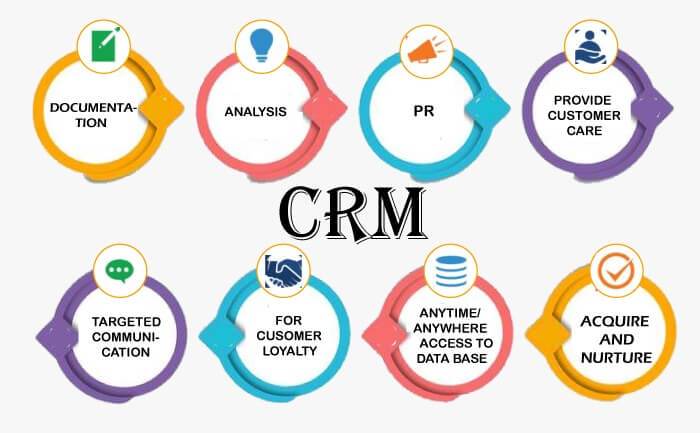
TYPES OF CRM
Three main types of CRM applications are explained below:
1. Operational CRMs
This CRM focuses on customer-centric business processes. These processes include selling, marketing, and services. The application provides client information, previous marketing efforts, past sales, etc., and summarizes the customer-firm relationship. It also sets up the interaction of the organization with its current and potential customers. The two best and most famous examples of operational CRMs are Salesforce and Hub spot.
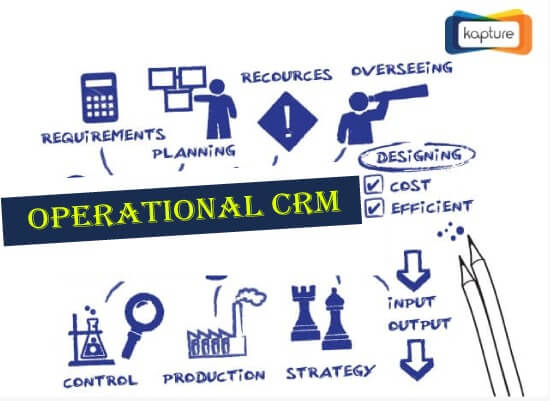
Operational CRM includes two main components that help in serving the top-notch experiences to the customers. They include:
- Salesforce Automation (SFA): SFA application helps in managing selling activities. The tool focuses on setting the organization to invite new customers and maintaining the existing customers. The information is organized by the application so that the company can increase its sales by keeping the customers need in mind. Some of its focused CRM sales modules are:
- Product Configuration: It permits designing the product or deciding its price to the salesperson or customers. It works on an if-then-else
- Quotation and Proposal Management: A quotation and proposal can be created by the salesperson related to the product price and customer details, respectively. These details include the customer's name, product code, delivered product, number of pieces, etc.
- Accounts Management: Under this module, a proper record of inward entries and credit and debit amounts for various business transactions are managed.
- Lead Management: With its help, the users can qualify leads and refer them to the correct salesperson.
- Contact Management: It helps keep a computerized record of customer's contact details, automatic dialing numbers, and salespersons' calendars. This record further helps in smooth and effective communication with the customers.
- Opportunity Management: It helps the users to recognize and follow the leads from their status to closure and beyond closure.
- Marketing Automation (MA): Marketing automation is used to providing products and services and approaching potential customers in the best possible way. It involves the following CRM marketing modules:
- Market Segmentation: This divides existing and potential customers into sub-groups as per the typical behavioral and consumption pattern. It helps in identifying the target audience and ideal customers. Some of the most common types of market segmentation are as under:
- Demographic
- Psychographic
- Geographic
- Behavioral
- Campaign Management: Planning, executing, tracking, and analyzing a marketing initiative is known as campaign management. Sometimes this management focuses on the launch of a new product or an event. These campaigns include several modes such as email, social media, surveys, print common issues or problems that may arise during the lifecycle of a project. These issues may include technical failures, problems of staff or suppliers, material shortages, etc. If these problems are ignored or not resolved on time, they may cause conflicts, delays, or even permanent failure of the project. To manage all the issues, it must have a strategic focus on listening, observing, research, data gathering and analyzing, and relationship management.
- Customer Call Management: This is a software tool used by call center agents and corporations to increase the efficiency of inbound call handling and enhance their customer's experience. These tools store data of customer's account information and contact history. This helps in understanding customer's history with the organization and personalize their contacts. The application provides accurate data that does not rely on assumptions of marketing and employee performance. CSL tracking or call recording is the foundation of any successful customer call management.
- Service Level Management: It is one of the five components of the ITIL Service Delivery Area. SLM is helpful in developing the Service Level Agreement (SLA) and Operational Level Agreements (OLA) so that the contracts can be completed. It also provides a framework to define the services, ages y to the service levels, and calculates the costs of underdeveloped services. The primary purpose of SLM is to make sure that all the services are delivered on time to the customers as per the previously set targets.
Benefits of Operational CRMs:
- It helps in managing a number of various marketing campaigns.
- It provides an option of self-service to the customers.
- It traces all the critical information from leads to sales KPIs.
- It sends reminders and assigns leads to all the recurring activities such as meetings and sales reps.
- It also helps in increasing the sales and revenues of the organization by gaining intuition.
2. Analytical CRMs
Analytical CRM is responsible for finding out the better way to provide services to the customers. This CRM helps the top management, sales, and marketing to analyze the data. This customer data provide insights related to the present status of the business organization. This analysis supports the management in better decision-making, marketing executives in understanding campaign effectiveness, sales executives in increasing sales, and personnel building strong customer relationships. If you want to improve the customer analysis of your business, then you may use Zoho Analytics or Wave: Salesforce Analytics Cloud, the two best applications for customer analysis.
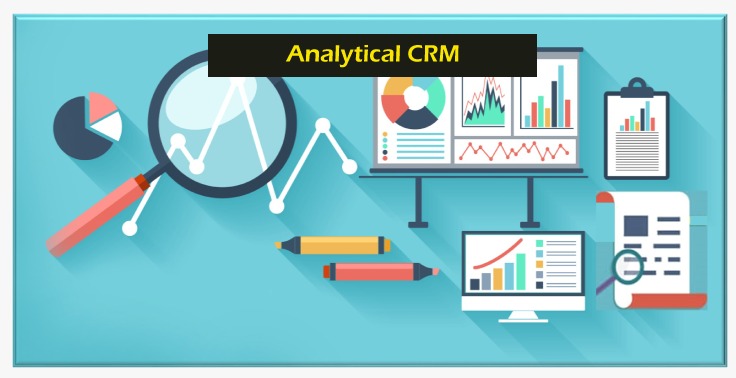
Its various tools are:
- Data Warehousing: The analytical CRM starts from this point. The place where unsold goods are stored for a temporary period is known as a warehouse. In the same manner, a data warehouse is a central place where data from various sources is integrated and stored. In simple terms, it is a way that helps in collecting, accessing, and organizing the data of the customers generated by all the departments. Only after following this module, an organization can move further to analyze and generate reports. Two main approaches include Extract, Transform, Load (ETL), and Extract, Load, Transform (ELT) together forms a data warehouse. The essential features of the data warehouse are:
- Subject Oriented: The focus of the data in the data warehouse is on the prime subject of the organization. It helps in effective decision-making.
- Data Integrated: The warehouse data is combined in such a way that it is stored without any inconsistency. They have complete consistency, including banking conventions, physical attributes, and measurement of variables, encoding structure, and many others.
- Time-variant: The data of the data warehouse is mainly used for its mining and forecasting. Because data warehouse mainly contains historical data that shows a long time horizon.
- Non-volatile Data: The data present in the data warehouse can't be updated, created, or deleted. It can only be read.
Data warehousing improves data quality, maintains data history, and restructure the data. Various design methods of the data warehouse are as under:
- Bottom-up Design: Data marts are formed so that some specific business processes can be performed by providing reporting and analytical capabilities. After it, these marts are combined to form a data warehouse.
- Top-down Design: This approach is created by using the data model of normalized enterprise. This design has the atomic data, the data at the most significant level of details in its data warehouse. The data for specific business processes or departments are stored in dimensional data marts.
- Hybrid Design: This DW database is the third standard form that removes data redundancy. This architecture supports the data replacement with a master data management repository.
There are three primary types of Data Warehouse which include:
- Enterprise Data Warehouse (EDW)
- Operational Data Store (ODS)
- Data Mart
Data Mining: This is the process of analyzing a large amount of data after collecting it at one place to discover business intelligence. It helps the organization in solving problems, mitigating risks, and seizing new opportunities. It is a complex technique that you can use to turn the basic information of your data into valuable insight. Data mining supports various statistical techniques such as association, classification, and anomaly detection. These techniques can be used to analyze data by identifying patterns, trends, and relationships. This analysis can be further used to identify future uncertainties, take proper measures to resolve them, understand customers, develop profitable marketing strategies, increase revenues, etc. Data mining is applicable in many fields such as sales and marketing, business and research, education, product development, and healthcare. Some commonly used functions of data mining are as under:
- Data Cleansing and Preparation: In this function, the transformation of data helps in further analyzing and processing. For example, finding and removing errors.
- Artificial Intelligence (AI): AI performs analytical activities along with human intelligence that includes planning, learning, reasoning, and problem-solving.
- Clustering: Under this process, a dataset is divided into sub-classes known as clusters. This partitioning helps in understanding the natural grouping or structuring.
- Classification: Under this technique, various dataset items are assigned to target categories. This is done to predict the target class for each case accurately.
- Machine Learning: Under this programming technique, the statistical probabilities are used to provide computers the ability to 'learn' without explicit programming.
- Association Rules Learning: These tools are used to know how variables in a dataset related to each other? For example, determining those products which are typically purchased by the customers together. The ARL tool is also known as Market Basket Analysis.
- Regression: This technique helps in forecasting the numerical values that are based on a particular set of data such as sales, stock prices, etc.
Online Analytical Processing (OLAP): It is a software tool that allows the same time analysis of the information from a set of various database systems. The analysts can extract and go through different sets of business data. The technique helps in faster analysis by pre-calculation and pre-aggregation of data. These databases have one more cube. Various types of OLAP area as follows:
- Relational OLAP (ROLAP): ROLAP performs the standard relational operations without pre-computation. It can drop down to the lowest level of detail in the database. These tools can easily handle textual descriptions. The speed of ROLAP makes it less effective than MOLAP. The tool is also not appropriate if the model is heavy on calculations.
- Multidimensional OLAP (MOLAP): MOLAP performs the operations in multidimensional data. Due to their optimized storage capacity, multidimensional indexing, and caching, MOLAP shows fast query performance. A common disadvantage of the tool is that the processing can be lengthy in some performance, while some may introduce data redundancy.
- Hybrid OLAP (HOLAP): The HOLAP tool helps the model designer in deciding whether data is to be stored in MOLAP or ROLAP. These tools can utilize pre-calculated cubes as well as relational data sources. HOLAP has the performance of MOLAP and the efficiency of ROLAP. This is because they can store detailed data in a relational database and aggregated totals in a multidimensional database.
- Desktop OLAP (DOLAP): The tool is used to download the data from the database locally or on the desktop so that it can be analyzed. It offers minimal functionalities hence is relatively cheaper than other OLAP tools.
- Web OLAP (WOLAP): WOLAP is a three-tiered architecture that works via a Web browser. Its three components are client, middleware, and database server.
- Mobile OLAP: This tool helps the users in analyzing and accessing data via mobile devices.
Benefits of Analytical CRMs:
- It enhances customer satisfaction.
- It increases customer retention rates.
- It finds out your weakness and helps to work on them.
- It helps in optimizing marketing campaigns.
- It targets leads, prospects, and buyers with applicable content.
- It makes a detailed report about the customer journeys and personas.
- It finds out the best customers to cross-sell and upsell.
- It increases the revenue by analyzing which product or service provides the most significant sell.
3. Collaborative CRMs
As clear from the name, collaborative CRMs help collaborate different teams in the organization and share the customers' required information. Operational CRMs deal with marketing and sales, and collaborative CRMs focus on better customer service.
The application not just helps the departments (like sales and marketing) to exchange quality information but also supports the teams. Without collaborative CRMs, it can be too difficult to share customer information between the departments because of their separate working process. Some of the best examples of collaborative CRMs applications are Pipedrive and Copper.
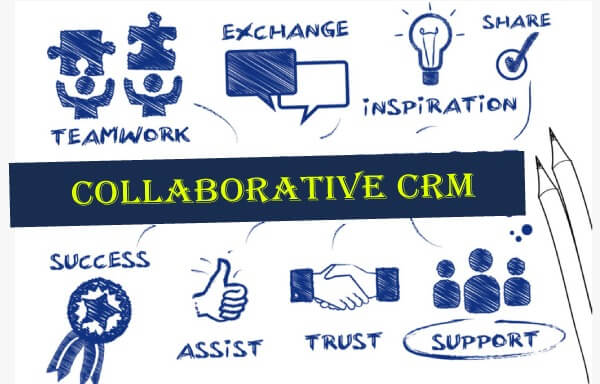
Its various modules are as follows:
- Interaction Management: This is an online application that helps in building a better relationship between an organization and its customers as well as vendors, partners, and employees, which improves their performance, delegation, and team building. This effective communication can take place through convenient ways to chat online, get customer feedback via polling or rating, send customers to online resources, share files, expertise and skill directories, etc. Effective interaction with customers helps in the smooth running of the business as it creates low-cost customer support services, helps customers to get experts' consult, creates incentive programs, provides an environment of online collaboration, etc.
- Channel Management: Under channel management, various marketing techniques and sales strategies are developed to reach the broadest possible number of customers. In order to develop programs for providing quality services to the customers and increase sales, the channels should be divided into segments as per the customers' characteristics, for example, needs, buying patterns and success factors, etc. After it, a program can be launched to include goals, policies, products, sales, and marketing programs.
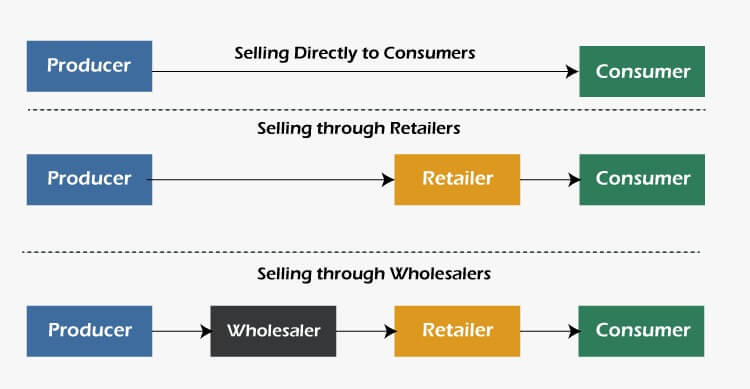
- Direct Marketing Channel: The medium in which no intermediary is involved in distributing goods or services is known as direct selling. In such a medium of distribution, the manufacturers directly sell the goods or services to the customers. It is also called Zero-Level Channel. This distribution network is widely popular in service-based businesses such as traveling, catering, salons, etc. Direct selling is also the most profitable and cost-efficient channel for small producers as it reduces the margins to intermediaries.
- Indirect Marketing Channel: The medium in which various intermediaries distribute the goods and services is called Indirect Marketing Channel. This channel is also called Selling through Intermediaries. The channel is further divided into three types as per the number of mediators involved:
- One-Level Channel: Under this channel, only a single middleman is involved in the distribution process. That single person is known as a retailer who buys goods from the producer and sells them to the end users. This channel is mainly used by shopping malls and retail marts. Other than this, producers of some particular products like furniture, footwear, clothing, etc., also prefer one-level channels.
- Two-Level Channel: Under this channel, the goods are bought by the wholesaler in bulk and then are supplied to various retailers in small quantities. In the end, the customers buy these goods from the retailers. This mode of distribution is preferred by those producers who want to grab the market. The two-level channel also increases the availability of the producers which helps in the mass production and a high amount of sales.
- Three-Level Channel: Under this channel, the individual agents or agencies are appointed by the producer for the further distribution of goods to selective wholesalers in bulk. These wholesalers sell the goods to the retailers, and then these retailers sell them to the customers. It is used by those producers who want to grab a large geographical area. This mode of distribution is mainly used for confectionery products. Other than this, peripheral goods are also preferred to distribute via a three-level channel.
- Strategic CRMs: Strategic CRM is helpful for the organization which focused on building long-term relationships with their customers instead of short campaigns and quick sales. Here, the customers are the priority of the business. The producers collect, segregate, and apply information about the customers and market trends so that they can provide a better value proposition to the customers. The organizations make a constant analysis of customers' needs and adapt them. Strategic CRM helps in increasing the market share and frequently buying customers. The various steps to develop and determine the CRM strategies are:
- Amplifying the commitments.
- Building a valuable project team from various departments.
- Analyzing the actual business requirements.
Benefits of Collaborative CRMs:
- It supports cross-team communication.
- It supports the customers consistently across their channels of choice.
- It provides messages related to the actual pain points.
- It combines data to get more precise information about the customers.
- It also manages the customer journey by providing a holistic approach.
|




 For Videos Join Our Youtube Channel: Join Now
For Videos Join Our Youtube Channel: Join Now










